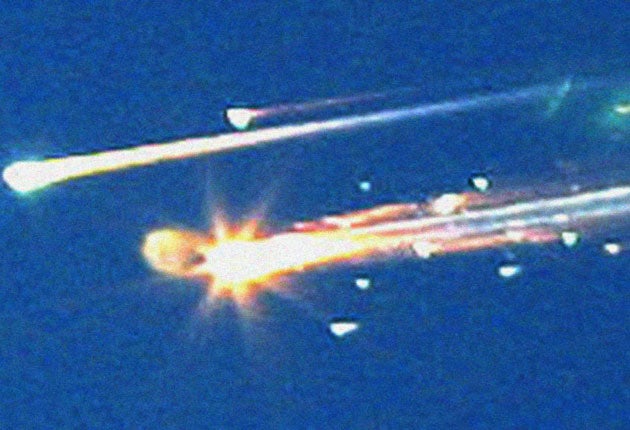Shuttle crew's last moments revealed
Columbia's safety equipment failed as doomed craft broke up on re-entry

There was no way the crew of the space shuttle Columbia could have survived the loss of their craft, but a Nasa report aimed at making future accidents more survivable has revealed that the seven-strong crew's safety harnesses and helmets failed during their final moments.
The astronauts survived the initial break-up of their ship but faced a series of fatal problems, including shoulder harnesses that failed, helmets that did not protect their heads and a parachute landing system that needed the crew to be conscious to activate it, according to the Columbia Crew Survival Investigation Report commissioned by Nasa on the 2003 disaster.
The report found, however, that even if their equipment had worked, they would still have died due to extreme conditions in the upper atmosphere. "Clearly the accident was not survivable under any circumstances, but [the report] will probably help for designing things for future spacecraft," said David Mould, Nasa's assistant administrator for public affairs.
The report is Nasa's most complete description to date of the final minutes of the shuttle mission, which lifted off on 16 January 2003 for a 16-day microgravity research mission that included, for the first time, an Israeli astronaut, Ilan Ramon. He and his six crewmates – commander Rick Husband, pilot William McCool and astronauts Michael Anderson, David Brown, Kalpana Chawla and Laurel Clark – died as the shuttle flew back toward the Kennedy Space Centre in Florida for landing after what had been widely regarded as a successful and fairly glitch-free mission.
Unknown to the astronauts or Nasa, Columbia had been critically damaged by a piece of foam debris that fell off its fuel tank during lift-off. The breach allowed superheated atmospheric gases to penetrate one of the wings during the high-speed glide back to Earth, melting it from the inside.
Much of what is in the report was discovered by the Columbia accident investigation team, which released a series of findings and recommendations. The panel advised retiring the space shuttles as soon as Nasa finishes the construction of the International Space Station, the $100bn (£68bn) project that has been under way for more than a decade.
Since the accident, Nasa has flown 11 shuttle missions and has nine left in its schedule. A 10th mission to carry out a physics experiment at the space station is under consideration.
Join our commenting forum
Join thought-provoking conversations, follow other Independent readers and see their replies
Comments